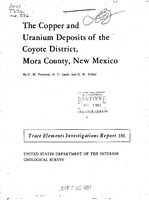The copper and uranium-vanadium deposits of the Coyote district, Mora County, N. Mec, are confined to the lower 2,000 feet of the Sangre de Gristo formation of Pennsylvanian and Permian age. A narrow belt of deposits in steeply dipping or overturned rocks extends for 7 miles along Coyote Creek south of Guadalupita. Earlier studies showed that the copper deposits contained uranium, but both the reserves and the uranium content of the copper-bearing
shale are too low to permit the recovery of uranium. However, small, commercial grade uranium deposits have been discovered in sandstone. Small lenses of copper-bearing carbonaceous shale, siltstone, limestone or sandstone, interbedded with predominantly red rocks, are present at intervals at 12 or more stratigraphic levels. The better deposits, in carbonaceous shale, average about 2 percent copper. The copper content of the other rocks is usually lower, but small concentrations may contain 6 percent copper. The principal copper minerals are chalcocite and malachite. Chalcocite replaces wood and forms nodules that contain small, variable amounts of pyrite, bornite, covellite, and rarely, uraninite. The uranium deposits occur as small closely spaced pockets that are commonly localized by sedimentary structures within one or more fluviatile arkosic sandstone beds near the middle of the formation, particularly" where carbonized wood, clay galls, and rock fragments are abundant. The uraniferous sandstone is commonly stained pink by hematite that probably was introduced with the uranium. The color increases in intensity with the radioactivity. The outcrops of the uranium deposits are typically inconspicuous, but close inspection shows they contain malachite, chalcopyrite, black vanadium minerals of micaceous habit, metatyuyamunite and microscopic
grains of an unidentified black uraniferous substance. The proportion of copper, uranium, and vanadium is variable and any metal may be dominant. The metals probably were derived from pre-Cambrian granitic rocks. Copper and minor amounts of uranium were deposited in local stagnant basins by reaction with hydrogen sulfide. and decaying organic material. The uraniferous shales and the copper deposits are believed to be syngenetic, or nearly so, but the uranium deposits in sandstone are epigenetic and probably were deposited from ground waters with a possible hydrothermal admixture. The uranium and vanadium may have been
reconcentrated from earlier, low-grade, syngenetic deposits.


